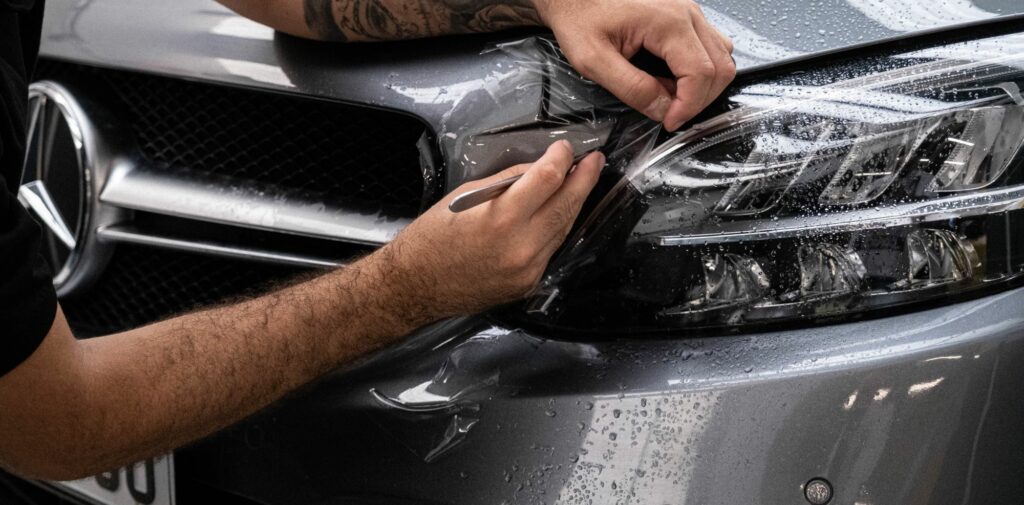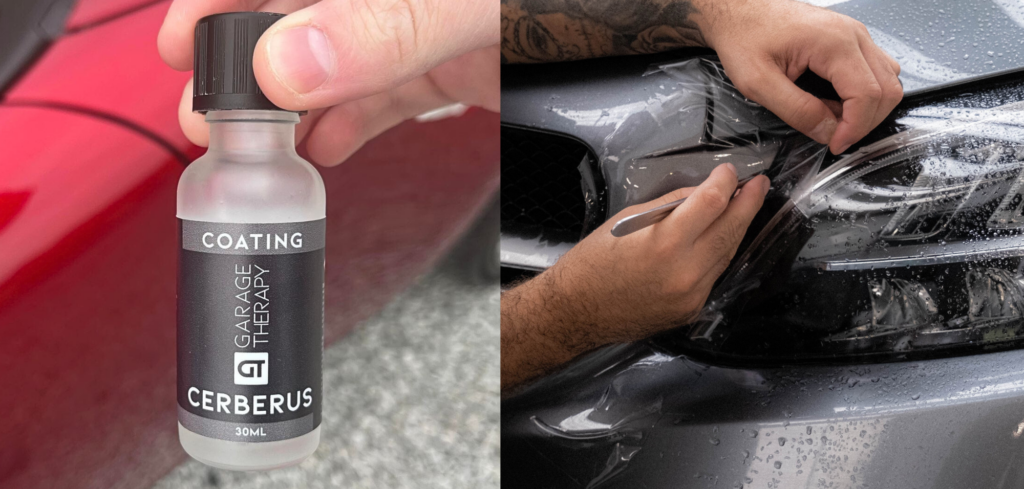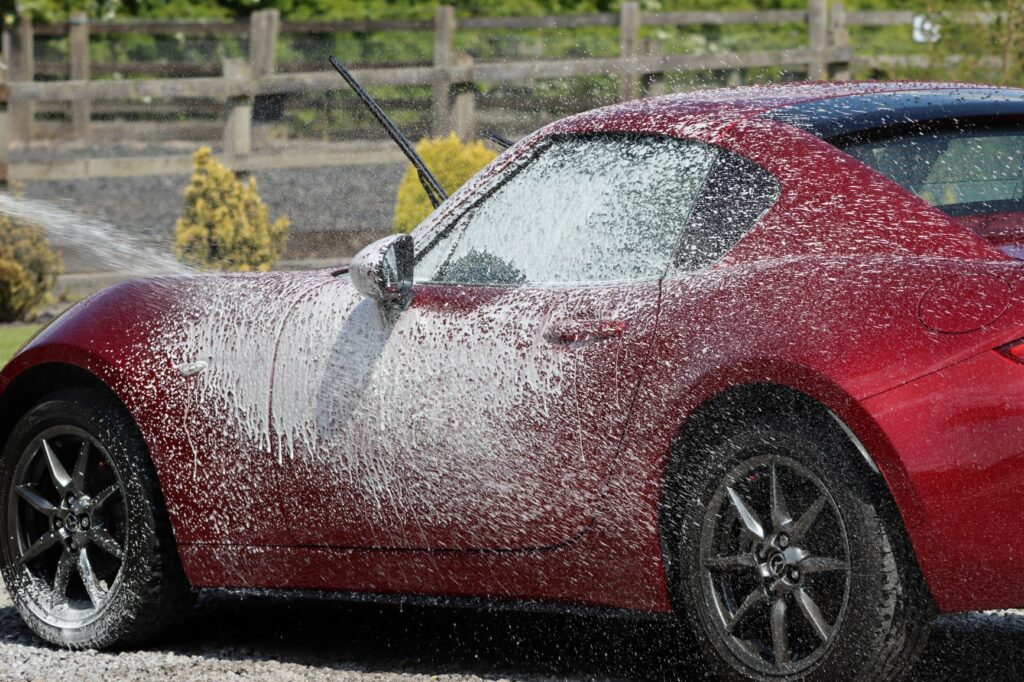If you’re looking for the ultimate way to protect your vehicle (and your investment), then you’ll known that ceramic coatings and paint protection films (PPF) are the industry-leading options. But which is the best choice?
In this article I’ll directly compare all the pros and cons of coating and PPF so you can figure out exactly which is the right option for your car, but if you’re in a rush, here’s the quick answer…
PPF provides much more resistance to stone chips and scratches compared to a ceramic coating. PPF typically lasts between 7-10 years whereas ceramic coatings last between 3-5 years on average. Ceramic coatings are cheaper and easier to install and are more chemically resistant than PPF.
| Ceramic Coating | Paint Protection Film (PPF) |
| Liquid polymer which cures to form a hardened layer of protection | Polyurethane film which is used to cover the surface |
| Very limited protection against impact e.g., scratches and stone chips | Offers the best protection against stone chips and scratches |
| Highly chemical resistant | Moderately chemically resistant |
| Typically last between 3-5 years | Typically last between 7-10 years |
| Relatively easy application process that can be done at home or even outdoors | Difficult application process which must be performed by a professional in a controlled environment |
| Takes 1-3 days to install | Takes 3-5 days to install |
| Costs between $1200-$1500 in the USA and £600-£800 in the UK | Costs between $1800-$5000 in the USA and £1500-£3500 in the UK |
Contents:
- What is a Ceramic Coating?
- What is PPF?
- Comparing the Pros and Cons
- Impact Resistance
- Chemical Resistance
- Hydrophobicity
- Gloss
- Durability
- Application Process
- Maintenance and Aftercare
- Cost
- Hybrid PPF and Ceramic Coating Options
What is a Ceramic Coating?
A ceramic coating is a liquid polymer which contains silicone dioxide. A ceramic coating is applied to the exterior surfaces on the car and left to cure (harden), after which it forms a hard layer of protection which lasts for 2-7 years, depending on the coating itself and the aftercare.
Check out this complete guide to ceramic coatings for more information.

What is PPF?
PPF stands for “paint protection film”. PPF is made from a very thin layer of polyurethane which is applied to the exterior surfaces of a vehicle in order to protect them from abrasion, chemicals and UV damage. PPF typically lasts for 7-10 years, depending on the type of film used, and the aftercare.

Comparing Pros and Cons
In this next section I’ll be directly comparing PPF and ceramic coatings in the following categories:
- Impact resistance (stone chips and scratches)
- Chemical resistance
- Hydrophobicity
- Gloss and finish
- Durability
- Application process
- Maintenance and aftercare
- Price
| Category | Best Option |
| Impact Resistance | PPF |
| Chemical Resistance | Ceramic Coating |
| Hydrophobicity | Draw |
| Gloss | Draw |
| Durability | PPF |
| Application Process | Ceramic Coating |
| Maintenance and Aftercare | Draw |
| Cost | Ceramic Coating |
Impact Resistance
PPF provides more protection against abrasion compared to a ceramic coating because they are both thicker and harder.
- PPF is approximately 150-200 microns thick
- A ceramic coating is approximately 1.5-2.0 microns thick
Ceramic coatings are liquid polymers which harden to form a tough layer or protection, however they are not very resistant to scratches and stone chips at all. Ceramic coatings are roughly 4-5 times harder than traditional clear coat paint, however they can still get mechanically damaged relatively easily, and only really provide protection against light swirls and marring which can typically occur when washing the car.
PPF on the other hand is much thicker and harder compared to a ceramic coating and hence provides much more protection. It is in the industry-standard in terms of scratch and stone-chip resistance. This is why PPF is most commonly applied to “high-impact areas” such as the front bumper, bonnet and door mirrors.
Although PPF is certainly not indestructible and will get damaged by heavier forms of abrasion and impact, it will help to shield the car against door dings and rock chips. Some PPF is also “self-healing” meaning that scratches in the film can be smoothed out when heat is applied.
Chemical Resistance
Ceramic coatings provide more chemical resistance compared to PPF.
Both forms of protection provide some shielding against things like:
- Bird poo
- Water spots
- Road salt
- Dirt and mud
However, ceramic coatings are more hardwearing against these contaminants and less likely to become damaged compared to PPF. It does depend on the exact coating and PPF though, as some are more chemically resistant than others.
Most ceramic coatings are tolerant to chemicals with a pH of 2-13 whereas most PPF products do not provide as much tolerance against strong acids and alkalis.
Hydrophobicity
In the past, ceramic coatings were always more hydrophobic than PPF however things have changed in recent years. There are several PPF products on the market that are highly hydrophobic and offer the same level of water repellence compared to the best ceramic coatings.
If you want your vehicle to be highly hydrophobic, you can go with either option. Just make sure you opt for a PPF product which is known for its hydrophobicity.

Gloss and Finish
This is highly subjective and very much dependent on the product in question. In some cases, a ceramic coating will look glossier, and in others, PPF will look glossier.
Most of the depth of gloss and reflectiveness of the finish comes from the preparation process, by refining the paintwork through machine polishing. What you then layer on top will make a visual difference however it is very difficult to detect by most people.
Either way, if you get an experienced professional to install either the coating or PPF, you’re unlikely stand back from your vehicle and be disappointed.
Durability
PPF is typically more durable than a ceramic coating:
- PPF lasts between 7-10 years on average
- Ceramic coatings last between 2-7 years on average
The durability of both PPF and coatings is highly dependent on three factors:
- The product itself
- The surface preparation and application technique
- How well the protection is maintained
It is possible to get highly durable ceramic coatings which last over 5-years, but the vast majority will last between 3-5 years. PPF is more durable and most leading brands offer a 10-year warranty with their products.
It is essential that the surfaces are properly prepared before applying PPF or ceramic coatings. This involves ensuring the paintwork is fully decontaminated, machine polished and all oils and residues are removed prior to applying the protection.
It is also vital that the correct chemicals and techniques are used in order to keep the protection in the best condition possible. In both cases, it is recommended to wash the vehicle every 2-3 weeks.

Application Process
Although the preparation process before applying both types of protection is relatively similar, the application process itself is very different.
Here’s a basic rundown of how each product is applied.
Ceramic Coating:
- Apply drops of coating onto the applicator
- Spread the coating in a cross-hatch pattern on a small section
- Wait the recommended flash time (usually 10 secs -2 mins depending on the coating)
- Use a microfiber towel to level the coating
- Use a second microfiber towel to remove the remaining residue
- Use third microfiber towel to ensure all residue has been removed
Paint Protection Film:
- The model of car is matched to a database
- The PPF is then printed out to the required dimensions
- The film is peeled and slid into place on the car
- The surface and film is sprayed with a gel/ glide solution
- The PPF is placed on the install area and sprayed with the gel
- A squeegee is used to flatten the film and remove any bubbles
Applying a ceramic coating at home by yourself is definitely possible as long as you are confident in the preparation process and able to apply the coating in decent conditions (usually less than 70% humidity and between 0°C-25°C (50°F-77°F) out of direct sunlight).
Check out my guide to applying a ceramic coating to learn more.
PPF on the other hand is much more complicated to apply and should only be done by a professional installer. The environment must be the correct temperature and completely free from dust in order to achieve a clean installation.
Time Required for Professional Installation:
- Ceramic coating: 1-3 days
- Front-end PPF: 2-3 days
- Full car PPF: 4-5 days
Maintenance and Aftercare
The aftercare procedure in the first 1-2 weeks can vary slightly for different products. Here are some typical guidelines:
- Ceramic coatings usually take 7 days to fully cure and should not be washed or exposed to any chemicals during this time. The car should also not be driven or get wet for the first 12-24 hours.
- PPF should not be washed or exposed to any chemicals for 48 hours (longer in some cases). The car should also not be driven or get wet for 24 hours.
If you are getting the protection professionally installed, they will usually keep the car indoors for 24 hours after application before you collect it to ensure that the most critical period has passed.
In terms of long term aftercare, the following rules apply for both PPF and ceramic coatings:
- Ideally wash the car every 2-3 weeks
- Do not take the car to automatic or roadside car washes
- Use soft microfiber wash mitts and microfiber towels instead of sponges/ brushes/ bath towels/chamois/ squeegees
- Use a wax-free/ gloss-free car shampoo and pre-wash chemical. Do not use household cleaners e.g. dish soap
- Do not polish or clay the surface
- Wash away contaminants such as bird poo as soon as possible
- Do not wash the car in direct sunlight
- Do not aim the pressure washer too close (especially on PPF edges)

Price
PPF installation is more expensive than a ceramic coating. This is due to the additional cost of the film itself, and the time-consuming and labour-intensive application process.
The cost of both PPF and coating installation varies depending on the current condition of the vehicle, and the size, but here is a rough guide.
- In the USA, PPF installation costs $1800 for front-end only and $5000 for the full vehicle. Ceramic coating application typically costs $1200.
- In the UK, PPF installation averages at £1500 for front-end only, and £3500 for the full car. Ceramic coating installation costs approximately £700.
Hybrid PPF and Ceramic Coating Options
Since PPF is so expensive, there are several options you can go for:
- Partial front-end (front-bumper)
- Full-front (front bumper, front fenders, hood and door mirrors)
- Full vehicle PPF
It is possible to get front-end PPF for example and then have the rest of the vehicle ceramic coated. This ensures the high-impact areas are shielded from stone chips, and the rest of the car still has a strong degree of protection against other forms of damage.
This is a significantly cheaper alternative to full-car PPF and a highly popular option.
Can You Layer PPF and Ceramic Coatings?
It is possible to apply a ceramic coating over PPF in order to provide additional chemical resistance, gloss and hydrophobicity. In some cases, this is not necessary and really depends on the quality of the PPF product used on the vehicle, but it is the best option if you want the ultimate level of protection.
PPF should not be applied on top of a ceramic coating as it will prevent the film from adhering.

